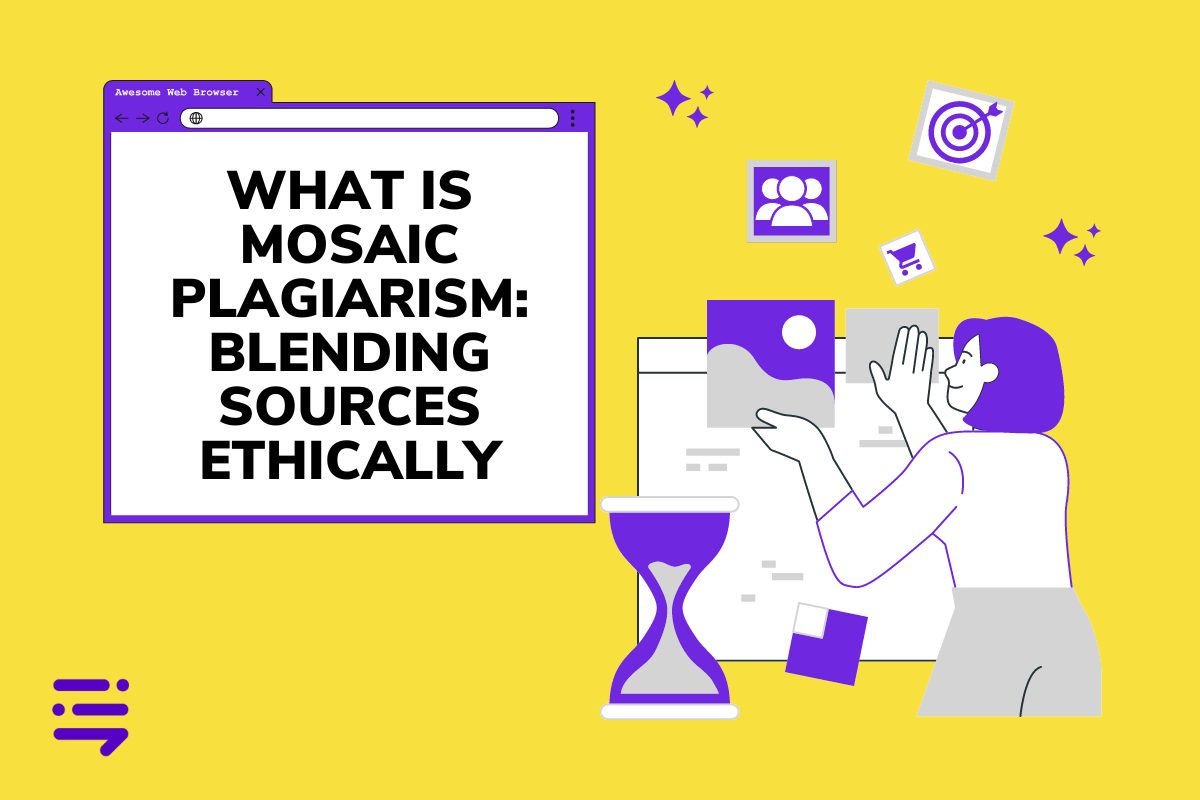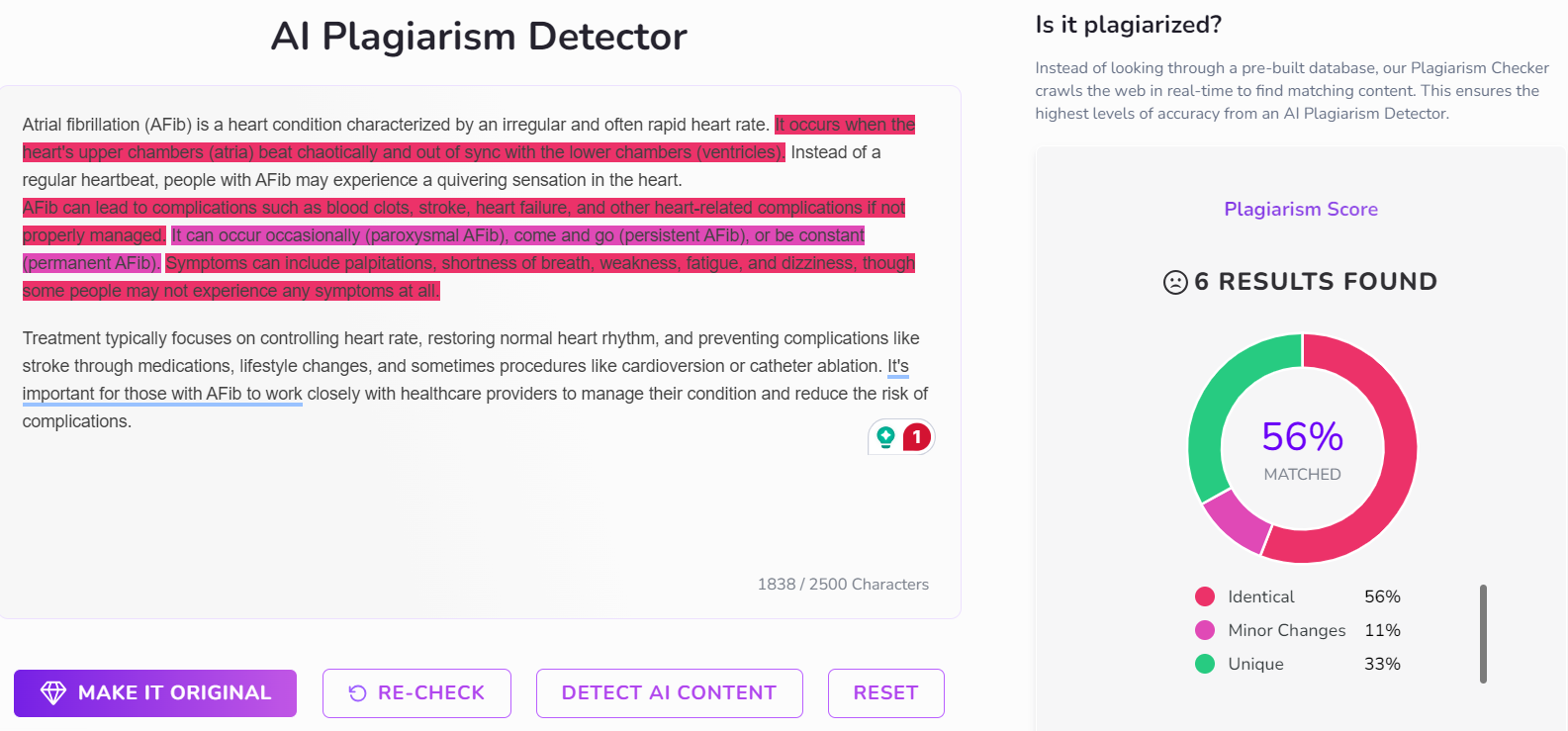Discover top guides, trends, tips and expertise from AIO Writers
What is Mosaic Plagiarism: Blending Sources Ethically
Julia McCoy
Thursday, 20th Jun 2024
Have you ever heard of a writing style called “patchwriting”? It might sound like something you’d do to fix up an old quilt, but it’s actually a form of plagiarism.
Specifically, mosaic plagiarism.
What is mosaic plagiarism, you might ask.
It’s a sneaky type of plagiarism where you take bits and pieces from different sources, change a few words here and there, and try to pass it off as your own work.
It’s like creating a mosaic, but instead of using tiles or glass, you’re using words and ideas from other people.
Now, you might think, “But I changed some of the words, so it’s not really copying, right?”
Unfortunately, it is.
Mosaic plagiarism occurs when you don’t properly cite your sources, even if you try to disguise the original work.
Table Of Contents:
- What Makes Mosaic Plagiarism Tricky
- Mosaic Plagiarism: Unintentional vs. Deliberate
- Real-Life Examples of Mosaic Plagiarism Consequences
- How to Avoid Mosaic Plagiarism
- FAQs: What is Mosaic Plagiarism?
- Conclusion
What Makes Mosaic Plagiarism Tricky
The reason mosaic plagiarism trips up a lot of people, especially students who are new to academic writing, is that it often happens accidentally.
We live in a world with information at our fingertips, and it’s easy to get caught up in researching and forget to jot down where each idea came from.
You might even convince yourself that you’ve paraphrased enough when you really haven’t.
The Dangers of Patchwriting
But why is this such a big deal? Why is patchwork plagiarism considered bad?
It all boils down to honesty and academic integrity. When you present a piece of writing as your own, you’re basically saying that you did the research, analysis, and synthesis of ideas yourself.
But if you’ve stitched together chunks of text from different sources without giving credit, you’re essentially taking credit for someone else’s hard work — that’s academic dishonesty.
Not only is this unfair to the original authors, but it can also have serious consequences.
Educational institutions and even workplaces take plagiarism very seriously. The penalties vary depending on the severity and intent — ranging from a failing grade on an assignment to expulsion from school or even getting fired from a job.
Mosaic Plagiarism: Unintentional vs. Deliberate
Now, to be fair, mosaic plagiarism can happen unintentionally, especially if you’re new to the whole concept of citing sources and are still getting the hang of paraphrasing.
We’ve all been there, staring at a blank page, feeling overwhelmed by the research.
However, it’s crucial to remember that even unintentional plagiarism is still plagiarism, and it’s your responsibility to learn how to avoid it.
Deliberate mosaic plagiarism, on the other hand, is a whole different ball game. This is when someone knows they’re copying but tries to get away with it by changing a few things around.
They might swap out synonyms or rearrange sentences, thinking they’re being slick.
However, professors and plagiarism checkers are getting pretty good at spotting these tactics, and let’s face it – it’s not worth risking your academic or professional reputation for.
To fully understand how mosaic plagiarism differs from other forms of plagiarism, read our recent blog post on the 15 Types of Plagiarism Disasters to Avoid which include blatant direct plagiarism, lazy self-plagiarism, and accidental plagiarism.
Real-Life Examples of Mosaic Plagiarism Consequences
Mosaic plagiarism is one of the most common types of plagiarism. It involves patching together phrases or sentences from different sources without proper attribution, creating a misleading impression of originality.
Here are some of the well-known instances:
- Doris Kearns Goodwin: In 2002, historian Doris Kearns Goodwin faced allegations of mosaic plagiarism in her book “The Fitzgeralds and the Kennedys.” Goodwin was accused of lifting many passages from other historians’ works without adequate attribution. As a result, she had to step down as a Pulitzer prize judge and withdrew all the unsold copies of the current edition of her book.
- Joe Biden: During his 1988 presidential campaign, Joe Biden faced accusations of plagiarism in a speech. He borrowed phrases and even whole passages from speeches by British politician Neil Kinnock without attribution, leading to controversy and questions about his integrity. Following more plagiarism allegations from his days in law school, Biden withdrew from the race three and a half months into the campaign.
- Martin Luther King Jr.: In his doctoral dissertation at Boston University, there were allegations of mosaic plagiarism concerning the use of sources without proper citation. Scholars have debated the extent and significance of these allegations.
- Quentin Rowan: In 2011, Quentin Rowan, writing under the pen name Q.R. Markham, published the novel “Assassin of Secrets.” It was discovered that Rowan had extensively plagiarized passages from other spy novels, combining them into his work without acknowledgment. His spy thriller was withdrawn from shelves following the controversy.
- Benny Johnson: In 2014, Benny Johnson, a journalist for BuzzFeed, was fired after an internal investigation revealed he had plagiarized other people’s work 41 times. He had lifted phrases and sentences from various sources without proper attribution.
- Fareed Zakaria: In 2012, journalist Fareed Zakaria was accused of mosaic plagiarism in his gun control article for Time magazine and CNN. Several instances were identified where Zakaria had used unattributed material from an article published in The New Yorker. Both Time and CNN suspended the famed foreign affairs specialist.
These examples illustrate how mosaic plagiarism can occur across various fields, from literature and history to journalism and politics, highlighting the importance of ethical writing practices and proper citation.
How to Avoid Mosaic Plagiarism
Now, for the million-dollar question – how can you avoid falling into the trap of mosaic plagiarism, particularly if it often happens unintentionally?
Develop Strong Note-Taking Habits
When you’re doing research, keep your sources organized. Whether you prefer using note cards, creating separate documents for each source, or utilizing a citation management tool – find a system that works best for you.
I’ve found that using different colored highlighters for each source helped me keep things clear.
Whatever you choose, the goal is to track where every idea originated and make it easy to cite correctly.
Master the Art of Paraphrasing
Instead of simply swapping out synonyms, focus on fully understanding the author’s meaning and expressing it in your own voice.
Remember that even with effective paraphrasing, you still need to cite the original source of the idea.
Here’s a complete guide on how to paraphrase effectively and avoid mosaic plagiarism.
Don’t Be Afraid to Ask for Help
Professors, librarians, and writing center tutors are fantastic resources. They’re there to help you succeed, so if you’re unsure about something, don’t hesitate to ask.
Don’t let fear or embarrassment keep you from seeking help – it’s better to ask a “silly” question than to commit an act of plagiarism.
When in doubt – cite.
Learn how to properly cite your sources here.
Use a Plagiarism Checker
Mosaic plagiarism can be sneaky. You grab bits and pieces from different sources, mix them up, and think you’re in the clear. But, it’s still plagiarism.
A good plagiarism checker like BrandWell will notice those borrowed phrases and flag them.
Look at this ChatGPT-written text flagged by BrandWell:

Checking for plagiarism — and fixing it — is super important because search engines don’t like duplicate content. It can hurt your rankings and damage your reputation.
Plus, you want your content to be original, right?
FAQs: What is Mosaic Plagiarism?
What is the difference between paraphrasing plagiarism and mosaic plagiarism?
Paraphrasing plagiarism happens when you reword a passage without citing the source. On the other hand, mosaic plagiarism, while it often involves paraphrasing plagiarism, takes it a step further by incorporating content from multiple sources, creating a patchwork of unoriginal work.
Which of the following is an example of mosaic plagiarism?
Let’s say you find a sentence from one source and then a sentence from another source. If you copy and paste those two sentences into your work, change a word or two in each sentence, and don’t cite – that would be an example of mosaic plagiarism.
Is mosaic plagiarism bad?
Yes, mosaic plagiarism is considered unethical and misleading as it involves piecing together phrases or sentences from different sources without proper attribution, which undermines the originality and integrity of one’s work.
How to correct mosaic plagiarism?
To correct mosaic plagiarism, carefully rephrase borrowed phrases and sentences into your own words, ensuring to provide proper citations for each source used. Review and revise your work thoroughly to integrate originality and transparency in attribution.
Conclusion
So what is mosaic plagiarism?
Mosaic plagiarism isn’t just about copying and pasting sentences here and there. It’s about weaving together borrowed phrases and ideas without giving credit where it’s due.
By understanding and avoiding this practice, we uphold the integrity of our writing and respect the contributions of others in the academic, creative, and professional arenas.
So, next time you’re crafting a piece, remember that creating authentic, original work is not only ethical but incredibly rewarding.

UNLOCK YOUR POTENTIAL
Long Headline that highlights Value Proposition of Lead Magnet
Grab a front row seat to our video masterclasses, interviews, case studies, tutorials, and guides.



